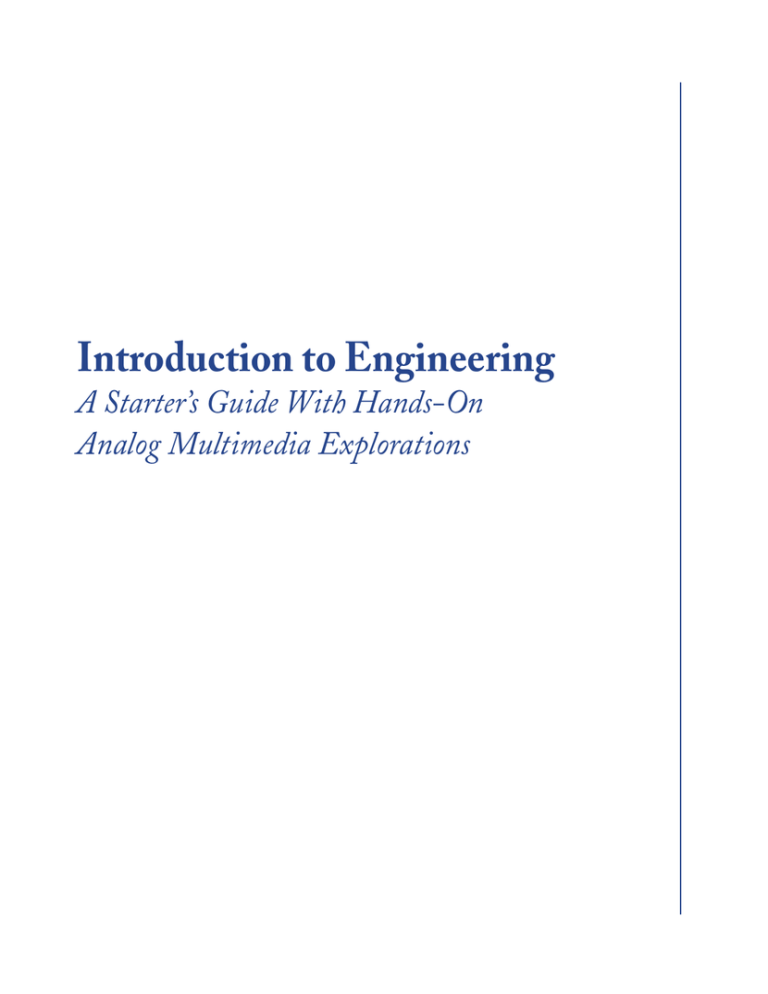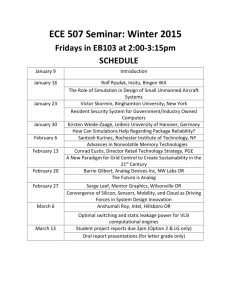
Introduction to Engineering
A Starter’s Guide With Hands-On
Analog Multimedia Explorations
Copyright © 2008 by Morgan & Claypool
All rights reserved. No part of this publication may be reproduced, stored in a retrieval system, or transmitted in any
form or by any means—electronic, mechanical, photocopy, recording, or any other except for brief quotations in
printed reviews, without the prior permission of the publisher.
Introduction to Engineering: A Starter’s Guide With Hands-On Analog Multimedia Explorations
Lina J. Karam and Naji Mounsef
www.morganclaypool.com
ISBN: 9781598297591 paperback
ISBN: 9781598297607 ebook
DOI: 10.2200/S00139ED1V01Y200806ENG006
A Publication in the Morgan & Claypool Publishers series
SYNTHESIS LECTURES ON ENGINEERING #6
Lecture #6
Series ISSN
ISSN: 1939-5221
print
ISSN: 1939-523X
electronic
Introduction to Engineering
A Starter’s Guide With Hands-On
Analog Multimedia Explorations
Lina J. Karam and Naji Mounsef
Arizona State University
SYNTHESIS LECTURES ON ENGINEERING #6
iv
Abstract
This lecture provides a hands-on glimpse of the field of electrical engineering. The introduced
applications utilize the NI ELVIS hardware and software platform to explore concepts such as
circuits, power, analog sensing, and introductory analog signal processing such as signal generation,
analog filtering, and audio and music processing. These principals and technologies are introduced
in a very practical way and are fundamental to many of the electronic devices we use today. Some
examples include photodetection, analog signal (audio, light, temperature) level meter, and analog
music equalizer.
Keywords
Analog, circuits, signal processing, filtering, audio, music, analog sensing, NI ELVIS, hands-on
applications.
Foreword
This volume provides a hands-on glimpse of the field of electrical engineering. The introduced applications utilize the NI ELVIS platform to explore concepts such as: circuits, power, analog sensing, and introductory analog signal processing such as signal generation, analog filtering, audio and
music processing. These principals and technologies are introduced in a very practical way and are
fundamental to many of the electronic devices we use today. Some examples include photodetection, analog signal (audio, light, temperature) level meter, and analog music equalizer.
The provided hands-on applications can be easily expanded into longer-duration design projects. Examples of such design projects can be found at http://www.fulton.asu.edu/~karam/introeng.
National Instruments Part Number Information
778748-02
NI ELVIS/PCI-6251 DAQBoard Bundle (Academic Use Only)
780378-01
NI ELVIS II Basic Bundle (Academic Use Only)
vii
Contents
1.
Getting Familiar with NI ELVIS...........................................................................1
1.1 Overview.............................................................................................................. 1
1.2 Background.......................................................................................................... 2
1.2.1 NI ELVIS................................................................................................. 2
1.2.2 NI ELVIS Workstation............................................................................ 3
1.2.3 NI ELVIS Protoboard.............................................................................. 9
1.3 Basic Circuit Components.................................................................................. 10
1.4 Experiment......................................................................................................... 12
1.4.1 Measuring Component Values............................................................... 12
1.4.2 Building a Voltage Divider Circuit on the NI ELVIS Protoboard......... 15
1.4.3 Using the DMM to Measure Current.................................................... 16
1.4.4 Using the Power Supply......................................................................... 18
1.4.5 Using the Function Generator and Oscilloscope.................................... 19
1.4.6 Photodetector Application..................................................................... 22
2.
Analog Signal Level Meter Using LEDs.............................................................. 25
2.1 Overview............................................................................................................ 25
2.2 Background........................................................................................................ 25
2.2.1 Diodes.................................................................................................... 25
2.2.2 Light-Emitting Diodes.......................................................................... 26
2.2.3 Comparators........................................................................................... 27
2.3 Experiment......................................................................................................... 28
2.3.1Application 1: Controlling 1 LED With One Comparator Using DC
Power Supply������������������������������������������������������������������������������������������28
2.3.2Application 2: Converting Varying Signal (AC) to Constant
Signal (DC)��������������������������������������������������������������������������������������������28
2.3.3 Application 3: First Stage of a Signal Level Meter��������������������������������29
2.3.4 Application 4: Eight-LED Signal Level Meter��������������������������������������30
viii a starter’s guide with hands-on analog multimedia explorations
3.
Noise Removal Using Analog Filters................................................................... 37
3.1 Overview............................................................................................................ 37
3.2 Background........................................................................................................ 37
3.3 Sinusoidal Signals and Frequency....................................................................... 38
3.4 What Is a Filter?................................................................................................. 40
3.5 Comparing Analog With Digital Filters............................................................ 41
3.6 Operational Amplifier........................................................................................ 42
3.7 Experiment......................................................................................................... 43
3.7.1 Part A. Low Pass Filter.......................................................................... 43
3.7.2 Part B. High Pass Filter.......................................................................... 45
3.7.3 Part C. Summing Signals....................................................................... 45
4.
Music Equalizer Using Op-Amps: Volume and Treble Control............................. 49
4.1 Overview............................................................................................................ 49
4.2 Background........................................................................................................ 50
4.2.1 Op-Amp as Amplifier............................................................................ 50
4.2.2 Potentiometers........................................................................................ 50
4.2.3 Treble Control........................................................................................ 51
4.3 Experiment......................................................................................................... 53
4.3.1 Volume Control...................................................................................... 53
4.3.2 Help Desk.............................................................................................. 54
4.3.3 Music Equalizer: Treble Control............................................................ 55
4.3.4 Combining Volume and Treble Control................................................. 56
References.................................................................................................................... 57
5.
Music Composer Using 555 Timers..................................................................... 59
5.1 Overview............................................................................................................ 59
5.2 Background........................................................................................................ 60
5.2.1 555 Timer............................................................................................... 60
5.2.2 Oscillator Circuit.................................................................................... 60
5.3 Experiment......................................................................................................... 61
5.3.1 Music Composer.................................................................................... 61
Author Biography....................................................................................................... 63

